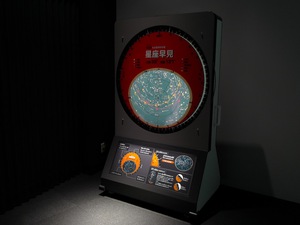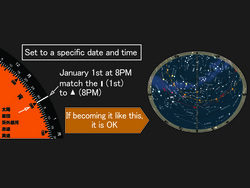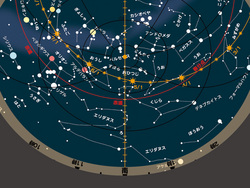Nagoya City Science Museum
TOP > Exhibition Guide > Keyword Search > Starting with "S" > star > Planisphere
Planisphere

Purpose of Exhibition
A planisphere is a useful tool for locating stars and constellations in the night sky. This exhibit displays an upright planisphere, which you can get your hands on and learn how to use. This is a huge model of what the Nagoya City Science Museum produces as a learning tool. You can buy a portable one at the museum shop.
We also have a free app version available for use on your smart phone or computer. You can get it from:
http://u0u1.net/VzEk


Additional Knowledge
How to use a planisphere to find stars:
[By Setting the Date and Time]
The outer edge of the rear disc of the planisphere is marked with the months and days throughout a whole year, and the front disc has 24-hour time scale. Rotate the discs to set the time you will look at the night sky. Next, read the direction and height from the horizon of the target star and search the sky.
Since the celestial sphere is made flat, the size of constellations on a planisphere is much different from the real ones in the sky, and their shapes are distorted. So, it is not practical to hold the chart above your head and look up the sky.
The Nagoya City Science Museum’s planisphere has the horizon lines at 30, 60 and 80 degrees, and the meridian lines at 5 degree increments from 0 to 80 degrees. The key to successfully finding the stars is to search based on azimuth and elevation.
[By Setting a Target]
Here’s how to find the best time to look at the star or constellation you want to see, instead of searching stars by a specific time. This method will give you the time when your target is on the north-south line, which is the moment the star appears at its highest and most precise orientation, in other words, the best conditions for observation.
1. Rotate the discs to align your target with the meridian.
2. Hold the discs steady and read the time and date combinations.
3. Read the altitude
4. Look at the southern sky at this date and time
5. And as you look up at that altitude, the desired star will be there waiting for you.
[How to Measure Angles Using Your Own Body]
You can measure angles by extending your arm straight out and making your fingers and hand widths in various shapes.
This page was last edited on 8 July 2022.
Article by Astronomy Section
